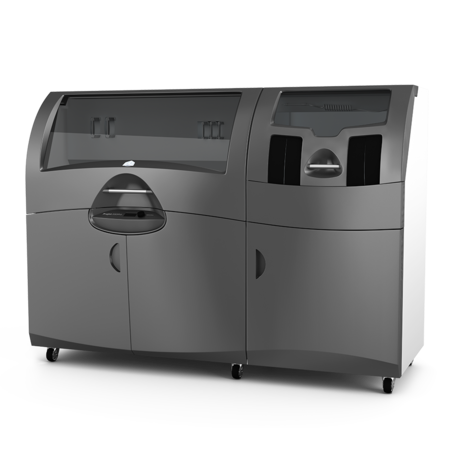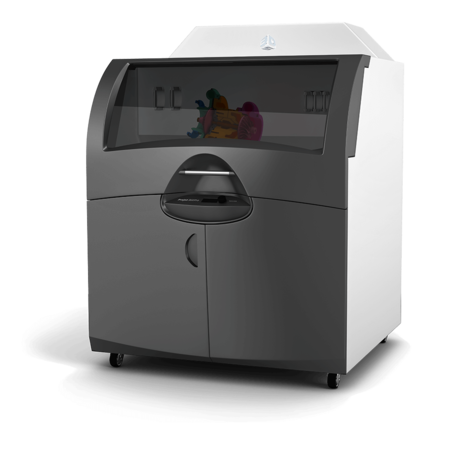If you're a design student at the Royal College of Art (RCA) and want a high-definition physical model for an automotive, architectural, medical or fine art project, it's not a question of whether you can get it done, only how.
Based in London, RCA operates the world's largest academic digital manufacturing facility, called Rapidform, which produces 7,000 prototypes a year. Rapidform has an unsurpassed array of 3D printing and rapid manufacturing machines, 10 in all, ranging from a device that produces low-definition wax models to an electronic beam melting machine that produces titanium parts.
As with any choice, however, there are trade-offs. Since students pay for their models and face deadlines as firm as those in the professional world, time, cost and quality are crucial variables. "In general all of our technologies are best for their particular niche." says Rapidform Manager Martin Watmough."
Challenge
Affordable iterations
In early 2003, students had far fewer rapid prototyping options. Rapidform was producing high-quality prototypes mostly via stereolithographic (SLA) and fused deposition modeling (FDM) techniques. Because these prototypes are costly, now 85 pence ($1.77 USD) per cubic centimeter, most students were compelled to wait until their computer-based designs evolved; that is, until the last minute, to request a prototype. Upon seeing the prototype, instructors would suggest design revisions, but it would often be too late. Confronting a deadline, students were forced to submit what they had developed, even if potential improvements were obvious. There was simply no opportunity left for feedback and iteration, an integral part of the design education process.
Solution
ColorJet Printing
In late 2003, Rapidform learned about the potential for a new generation of 3D printing technology that could solve this problem and create high-definition full color 3D physical models in a fraction of the time at a fraction of the cost of other methodologies. These ColorJet Printers (CJP) are the world's fastest 3D printers and only ones that can print in multiple colors. Rapidform decided to purchase a ProJet CJP 360.
Results
Affordable feedback, unlimited iteration
"Adding CJP enabled students to quickly obtain 3D physical models at a fraction of the previous price so they could receive more feedback earlier in the design process," says Watmough. "As a result, there was suddenly every opportunity for multiple iterations. Communication improved dramatically, resulting in significantly improved designs. The transformation was remarkable.
"Rapidform has since added two more Printers, the ProJet CJP 660, which produces high-definition, full-color prototypes, and the new ProJet CJP 460, which is the lowest priced and most office-friendly 3D printer available, also with full-color capabilities. Parts printed with these machines cost less than one-third of SLA produced parts and print five to ten times faster.
Students typically create their designs in Rhino™, SolidWorks® or formZ™ 3D computer-aided design (CAD) software. CJP printers use inkjet technology to build models layer by layer. "CJP printers are fast and affordable to operate while producing a high-quality model, making them a favorite for many student applications," says Watmough. "This is the technology of choice for our vehicle designers because it produces large models at a low cost. The speed, affordability, and color capabilities have also made it an attractive model creation alternative for the architectural, medical and fine arts disciplines. Sculptors love 'CJP.' They opt for it for both scale models and finished pieces and enjoy having a new way of working with the plaster-like composite material, with the option for color.
"In addition to giving students low-cost options for faster prototype production, the ProJet CJP 460 has offered an unprecedented side benefit, extending the space in the Rapidform facility. "The 460's integrated depowdering chamber effectively created room for an additional printer.
Giving RCA students rapid prototyping options like these is just one of Rapidform's responsibilities. Rapidform acts as a service bureau for other higher education institutions around London, such as the Bartlett School of Architecture at the University College of London. In one of the more remarkable applications, a student there, Tobias Klein, used CJP technology to produce the prize-winning design for an "inverted chapel" proposed for Havana, Cuba, featuring an intricate façade patterned after animal bones.
Rapidform is also chartered by the London Development Agency as a prototyping service bureau to small and medium businesses. More than once, Rapidform has exposed a business to CJP, prompting the business to purchase a printer of its own. One such firm, Kohn Pedersen Fox of London, uses ColorJet Printing to produce cityscape models with colored lines depicting utilities.
"London doesn't have a defined 3D printing service bureau, and we would never want to compete with one if it did. Our raison d'etre is to accompany small and medium companies through the early stages of their evaluation of the technology, then hand them off to a commercial service bureau or their own printing practice," says Watmough.
"Whether for business or education, CJP printers are only one of many rapid prototyping options at the Royal College of Art, but their speed, color, quality and affordability advantages make them indispensable for the university and its students."

